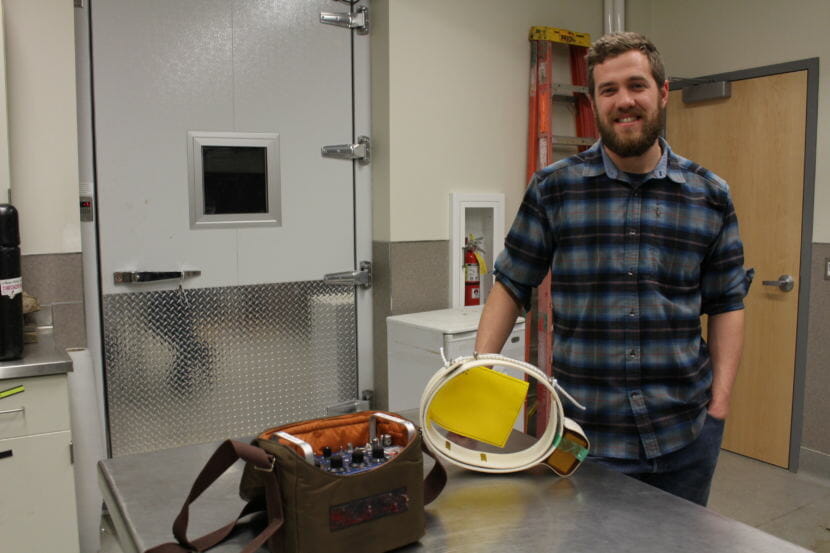
Moose weren’t always a staple in Western Alaska. The animals migrated to the region sometime after the turn of the century. But outside of Nome, the population has been continuing to decrease, following years of heavy snow.
Warren Hansen is counting down the days until he can fly over the tundra to look for moose. Although he’ll be searching the landscape with his eyes, his ears will be doing most of the work.
“Listening to static and beeps all day and trying not to get motion sick,” Hansen said.
Hansen is a wildlife biologist with the Alaska Department of Fish & Game (ADF&G).
In the aircraft, that beeping sound will be transmitted from Hansen’s moose to a radio receiver. Or rather, the 16 calves he collared last fall.
Right now, those calves are somewhere outside of Nome, wearing the chunky white collars Hansen gave them. Hopefully, they’re emitting a sound that indicates they’re alive. But a mortality signal could be closer to the truth.
In an area north of Nome, the moose population is decreasing by about 12 percent annually. Hansen says moose are an important subsistence food, so a shrinking population is concerning.
About a year ago, the department of fish and game received federal and state money to look into the issue.
But if this were a detective story, Hansen says it’s only the first chapter in figuring out what’s going on with moose.
Moose turned up near Nome around the 1930s, and scientists aren’t totally sure why. It’s possible they could have just naturally migrated into the area, much to the delight of local hunters.
“Well, [moose] may not have been barreling through,” said Tony Gorn, a management biologist for ADF&G. “But it was probably an impressive sight to see this long-legged animal standing on a hillside.”
Gorn has lived in Nome for 20 years, and he’s spent most of that time working with ADF&G.
Back in the 1980s the moose population was booming. So much so that biologists wondered if the landscape could even sustain it. And by the late 2000s, Gorn was on the job — capturing calves to weigh them and see how the animals were getting on.
At first, the young moose were a normal weight. But for the next two years, heavy snow fell in Nome, and their weight dropped. Management biologists wondered if there were too many moose, so they increased the hunting quota to ensure a sustainable population.
But since then the population started to decline more rapidly.
Gorn says it’s too early to tell exactly what’s going on. It’s complicated. But nutrition could be a factor.
“There’s definitely not one thing we could call the silver bullet,” Gorn said.
Still, one thing’s for certain: winters in Nome are not as cold as they used to be. At around 30 degrees, you get warm, wet conditions, which can lead to more snow and ice.
Measuring snowpack is challenging because it can blow across the tundra. But the National Weather Service has recorded more seasonal snowfall than what was typical just a few decades ago.
As for moose, Gorn says the animals are hardy. They’re built to handle heavy snow, but their environment, at least around Nome, appears to be changing.
Moose eat shrubby plants like willow.
“You know, we see our willows completely encased in ice,” Gorn said. “Those are things that we need to begin to understand. Particularly, if they’re going to be become long term events.”
But for now, he says the emphasis is on what is happening to moose. Not necessarily why. Are they malnourished? Migrating farther north? Are the calves being eaten? Those are the big questions.
When this study is done in about three years, ADF&G hopes to have a better understanding. This research could influence management decisions down the line to help stabilize the population.
Gorn says the goal is to achieve the best science possible within the confines of public support.
In the meantime he plans to go back out into the tundra this spring with his colleague to check on the young moose.
“If the weather was beautiful tomorrow, we’re not flying,” he said.
Gorn says right now the plane is a solid block of ice. The mystery is when the weather will be clear enough to fly.
